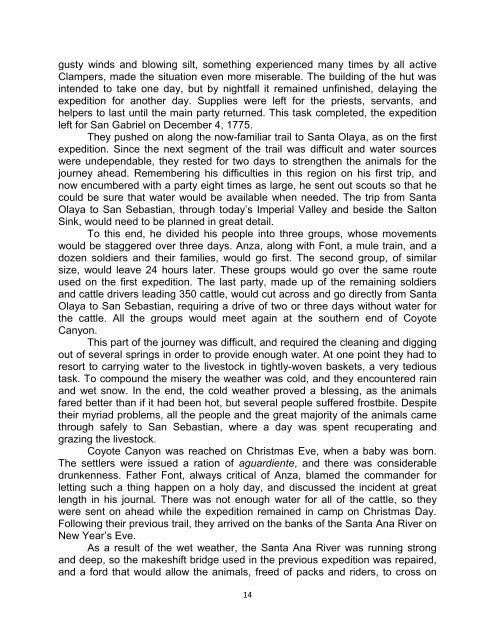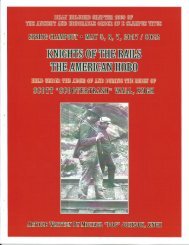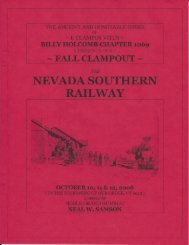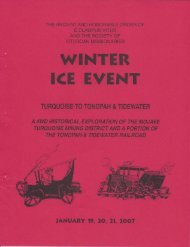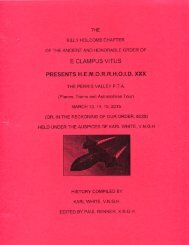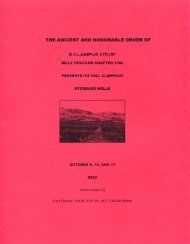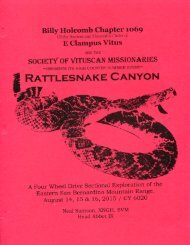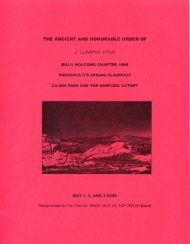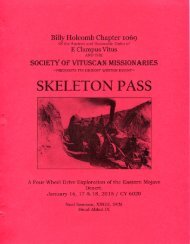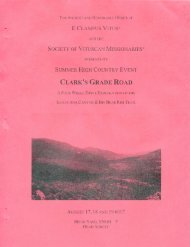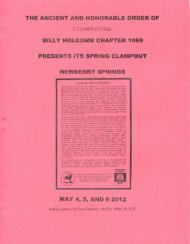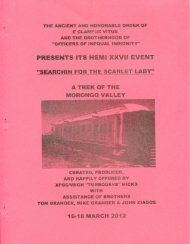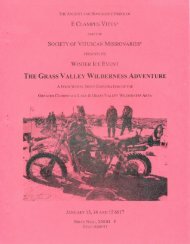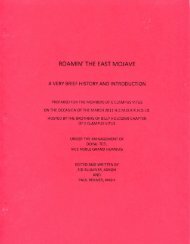6023 Spring Doins ANZA EXPEDITIONS History
You also want an ePaper? Increase the reach of your titles
YUMPU automatically turns print PDFs into web optimized ePapers that Google loves.
gusty winds and blowing silt, something experienced many times by all active<br />
Clampers, made the situation even more miserable. The building of the hut was<br />
intended to take one day, but by nightfall it remained unfinished, delaying the<br />
expedition for another day. Supplies were left for the priests, servants, and<br />
helpers to last until the main party returned. This task completed, the expedition<br />
left for San Gabriel on December 4, 1775.<br />
They pushed on along the now-familiar trail to Santa Olaya, as on the first<br />
expedition. Since the next segment of the trail was difficult and water sources<br />
were undependable, they rested for two days to strengthen the animals for the<br />
journey ahead. Remembering his difficulties in this region on his first trip, and<br />
now encumbered with a party eight times as large, he sent out scouts so that he<br />
could be sure that water would be available when needed. The trip from Santa<br />
Olaya to San Sebastian, through today’s Imperial Valley and beside the Salton<br />
Sink, would need to be planned in great detail.<br />
To this end, he divided his people into three groups, whose movements<br />
would be staggered over three days. Anza, along with Font, a mule train, and a<br />
dozen soldiers and their families, would go first. The second group, of similar<br />
size, would leave 24 hours later. These groups would go over the same route<br />
used on the first expedition. The last party, made up of the remaining soldiers<br />
and cattle drivers leading 350 cattle, would cut across and go directly from Santa<br />
Olaya to San Sebastian, requiring a drive of two or three days without water for<br />
the cattle. All the groups would meet again at the southern end of Coyote<br />
Canyon.<br />
This part of the journey was difficult, and required the cleaning and digging<br />
out of several springs in order to provide enough water. At one point they had to<br />
resort to carrying water to the livestock in tightly-woven baskets, a very tedious<br />
task. To compound the misery the weather was cold, and they encountered rain<br />
and wet snow. In the end, the cold weather proved a blessing, as the animals<br />
fared better than if it had been hot, but several people suffered frostbite. Despite<br />
their myriad problems, all the people and the great majority of the animals came<br />
through safely to San Sebastian, where a day was spent recuperating and<br />
grazing the livestock.<br />
Coyote Canyon was reached on Christmas Eve, when a baby was born.<br />
The settlers were issued a ration of aguardiente, and there was considerable<br />
drunkenness. Father Font, always critical of Anza, blamed the commander for<br />
letting such a thing happen on a holy day, and discussed the incident at great<br />
length in his journal. There was not enough water for all of the cattle, so they<br />
were sent on ahead while the expedition remained in camp on Christmas Day.<br />
Following their previous trail, they arrived on the banks of the Santa Ana River on<br />
New Year’s Eve.<br />
As a result of the wet weather, the Santa Ana River was running strong<br />
and deep, so the makeshift bridge used in the previous expedition was repaired,<br />
and a ford that would allow the animals, freed of packs and riders, to cross on<br />
14


